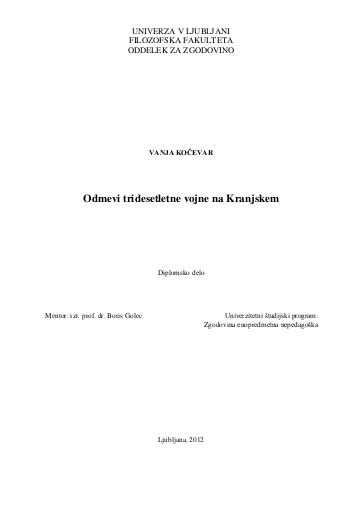/
Thesis and textbooks
/
Graduate Thesis
Echoes of the Thirty Years' War in Carniola

Author(s):Vanja Kočevar
Co-author(s):Boris Golec (ment.)
Year:2012
Publisher(s):Univerza v Ljubljani, Filozofska fakulteta, Ljubljana
Language(s):slovenščina, angleščina
Type(s) of material:text
Keywords:tridesetletna vojna, vojvodina Kranjska, Kolegij družbe Jezusove v Ljubljani, knezoškof Tomaž Hren, Janez Vajkard Valvasor, Slava vojvodine Kranjske, Thirty Years' War, college of Society of Jesus in Ljubljana, Duchy of Carniola, prince bishop Tomaž Hren, Janez Vajkard Valvasor, Die Ehre dess Hertzogthums Crain
Rights:

This work by Vanja Kočevar is licensed under Creative Commons Attribution-NonCommercial-NoDerivs 4.0 International
Files (1)

Name:DIPLOMA-Kocevar.pdf
Size:1.13MB
Format:application/pdf
Permanent link:https://hdl.handle.net/11686/file9584
Description
The thesis tempts to brighten the views on the Thirty Years' War in the Holy Roman Empire of the German Nation that its contemporaries in the Duchy of Carniola had had. The land was never directly damaged by this war, even though this duchy belonged in the south of empire to a complex of Habsburg lands which enabled its own dynasty the engagement on the battlefields by paying the taxes. After the war had ended, the hereditary lands started to connect and alongside with the introduction of absolutism the Austrian state finally arose from the complex of Habsburg lands. Time before and during the war was in Carniola also significantly marked by the Counter-Reformation – this process had had a delay in the Habsburg territories in comparison to the lands in the centre of the empire – and introduction of absolutism which made an end to state-dynastic dualism. Progress of processes, Counter-Reformation as well as introduction of absolutism, depended on circumstances on European battlefields. Thus the Emperor Ferdinand II had taken advantage of victory over Denmark and imposed the edict of restitution on states of the empire, the renewed land constitution and absolutism on Czech lands and expulsion of protestant nobility in inner Austrian lands. Thesis presents Carniolan view on European events in the first half of 17th century based on four sources. In the first chapter the Thirty Years' War and the Duchy of Carniola are briefly presented. The second chapter handles with the view on the war that the College of Jesuits in Ljubljana had had. The source was the yearbook of Society of Jesus Historia annua. The third chapter examines the work of Ljubljana's prince bishop Tomaž Hren who led the Counter-Reformation in Carniola and was the inner Austrian governor at the time of the Thirty Years' War outburst. Description of his view on war is based on his calendar notes. This subject is also discussed in subchapter about the Sikst Carcano's apostolic visitation. Based on decrees of Carcano's visitation the course of Counter-Reformation in the hinterland of the Thirty Years' War is depicted. The last, fourth chapter treats the mentioning of Thirty Years' War in the work Die Ehre dess Hertzogthums Crain (1689) that was written by Janez Vajkard Valvasor and Erasmus Francisci. The curiosity of this work is the interconnection of catholic and protestant influences.
Metadata (12)
- identifierhttps://hdl.handle.net/11686/20236
- title
- Odmevi tridesetletne vojne na Kranjskem
- Echoes of the Thirty Years' War in Carniola
- creator
- Vanja Kočevar
- contributor
- Boris Golec (ment.)
- subject
- tridesetletna vojna
- vojvodina Kranjska
- Kolegij družbe Jezusove v Ljubljani
- knezoškof Tomaž Hren
- Janez Vajkard Valvasor
- Slava vojvodine Kranjske
- Thirty Years' War
- college of Society of Jesus in Ljubljana
- Duchy of Carniola
- prince bishop Tomaž Hren
- Janez Vajkard Valvasor
- Die Ehre dess Hertzogthums Crain
- description
- Diplomsko delo skuša osvetliti, kako so na tridesetletno vojno v tako imenovanem Svetem Rimskem cesarstvu nemške narodnosti gledali njeni sodobniki v vojvodini Kranjski. Dežele spopadi te vojne sicer niso nikoli neposredno prizadeli, vendar je vojvodina na skrajnem jugu cesarstva pripadala kompleksu habsburških dednih dežel, ki je svoji dinastiji s plačevanjem davkov omogočil angažma na bojiščih. Po končani vojni so se dedne dežele ob uvedbi absolutizma začele vedno bolj povezovati in končno je iz kompleksa habsburških dednih dežel nastala avstrijska država. Čas pred in med vojno je na Kranjskem pomembno zaznamovala še protireformacija, ki je v habsburških deželah nekoliko zaostajala za teritoriji v osrčju cesarstva, ter uvajanje absolutizma, ki je naredilo konec stanovsko-dinastičnemu dualizmu. Napredovanje obeh procesov, tako protireformacije kot tudi uvajanja absolutizma, je bilo odvisno od razmer na evropskih bojiščih. Tako je cesar Ferdinand II. izkoristil zmago nad Dansko in stanovom cesarstva vsilil restitucijski edikt, češkim deželam prenovljen deželni red in absolutizem, notranjeavstrijskim deželam pa izgon protestantskega plemstva.Delo kranjski pogled na evropsko dogajanje prve polovice 17. stoletja predstavlja na podlagi štirih virov. V prvem poglavju sta kratko predstavljeni tridesetletna vojna in vojvodina Kranjska. Drugo poglavje predstavlja pogled na vojno jezuitov ljubljanskega kolegija. Kot vir je služil letopis Družbe Jezusove Historia annua. Tretje poglavje obravnava delovanje ljubljanskega knezoškofa Tomaža Hrena, vodje protireformacije na Kranjskem in notranjeavstrijskega namestnika ob izbruhu tridesetletne vojne. Njegov pogled na vojno je orisan na podlagi koledarskih zapiskov. Na to temo se navezuje še podpoglavje o apostolski vizitaciji Siksta Carcana. Na osnovi dekretov Carcanove vizitacije je predstavljen potek protireformacije v zaledju tridesetletne vojne. V zadnjem, četrtem poglavju so predstavljene omembe vojne v Slavi vojvodine Kranjske (1689), ki sta jo napisala Janez Vajkard Valvasor in Erasmus Francisci. Njena zanimivost je mešanje katoliških in protestantskih vplivov.
- The thesis tempts to brighten the views on the Thirty Years' War in the Holy Roman Empire of the German Nation that its contemporaries in the Duchy of Carniola had had. The land was never directly damaged by this war, even though this duchy belonged in the south of empire to a complex of Habsburg lands which enabled its own dynasty the engagement on the battlefields by paying the taxes. After the war had ended, the hereditary lands started to connect and alongside with the introduction of absolutism the Austrian state finally arose from the complex of Habsburg lands. Time before and during the war was in Carniola also significantly marked by the Counter-Reformation – this process had had a delay in the Habsburg territories in comparison to the lands in the centre of the empire – and introduction of absolutism which made an end to state-dynastic dualism. Progress of processes, Counter-Reformation as well as introduction of absolutism, depended on circumstances on European battlefields. Thus the Emperor Ferdinand II had taken advantage of victory over Denmark and imposed the edict of restitution on states of the empire, the renewed land constitution and absolutism on Czech lands and expulsion of protestant nobility in inner Austrian lands. Thesis presents Carniolan view on European events in the first half of 17th century based on four sources. In the first chapter the Thirty Years' War and the Duchy of Carniola are briefly presented. The second chapter handles with the view on the war that the College of Jesuits in Ljubljana had had. The source was the yearbook of Society of Jesus Historia annua. The third chapter examines the work of Ljubljana's prince bishop Tomaž Hren who led the Counter-Reformation in Carniola and was the inner Austrian governor at the time of the Thirty Years' War outburst. Description of his view on war is based on his calendar notes. This subject is also discussed in subchapter about the Sikst Carcano's apostolic visitation. Based on decrees of Carcano's visitation the course of Counter-Reformation in the hinterland of the Thirty Years' War is depicted. The last, fourth chapter treats the mentioning of Thirty Years' War in the work Die Ehre dess Hertzogthums Crain (1689) that was written by Janez Vajkard Valvasor and Erasmus Francisci. The curiosity of this work is the interconnection of catholic and protestant influences.
- publisher
- Univerza v Ljubljani
- date
- 2012
- type
- besedilo
- language
- Slovenščina
- Angleščina
- rights
- license: ccByNcNd
- fileResource
Citirano v (1)
| Tipologija | Avtor(ji) | Naslov | Kraj | Založba | Leto |
|---|---|---|---|---|---|
| 1.01 Izvirni znanstveni članek | Kočevar, Vanja | Ali je slovenska etnična identiteta obstajala v prednacionalni dobi? : kolektivne identitete in amplitude pomena etničnosti v zgodnjem novem veku | Ljubljana | Zveza zgodovinskih društev Slovenije | 2020 |
